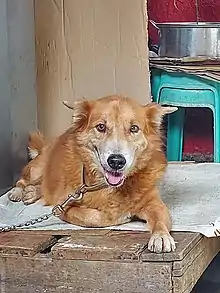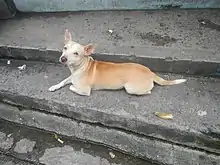Askal
Askal (portmanteau of asong kalye, meaning "street dog"), also called aspin (portmanteau of asong Pinoy, meaning "Filipino dog"), refers to the diverse population of mongrel dogs found in the Philippines. The term "Askal" is derived from the Filipino language and is commonly used to describe stray or mixed-breed dogs that roam the streets of urban and rural areas across the country.
| Askal | |||||||||||||||||||||||||||||||||
|---|---|---|---|---|---|---|---|---|---|---|---|---|---|---|---|---|---|---|---|---|---|---|---|---|---|---|---|---|---|---|---|---|---|
 A male askal on the beach. | |||||||||||||||||||||||||||||||||
| Other names | Ayam, Irong Bisaya, Aspin | ||||||||||||||||||||||||||||||||
| Origin | Philippines | ||||||||||||||||||||||||||||||||
| Breed status | Not recognized as a breed by any major kennel club. | ||||||||||||||||||||||||||||||||
| |||||||||||||||||||||||||||||||||
| Dog (domestic dog) | |||||||||||||||||||||||||||||||||
The origins of Askals can be traced back to two main categories. Firstly, some Askals are entirely descended from indigenous dog breeds that have evolved over time in the Philippines. These native breeds have adapted to the local environment and exhibit a range of physical characteristics and temperaments. These dogs have played an integral role in the lives of Filipinos, serving as loyal companions, guardians, and even working animals.[1][2]
Askals often display a unique blend of characteristics from various ancestral backgrounds. This diversity contributes to their distinct appearance, temperament, and adaptability. They are highly adaptable and resilient dogs, capable of surviving in challenging conditions. They possess a remarkable ability to navigate the urban landscape and survive on scraps and leftovers. Their resourcefulness, intelligence, and innate street-smarts have earned them the nickname "asong kalye," reflecting their association with the streets.
In recent years, there has been a growing movement to celebrate and protect the cultural heritage represented by Askals. Various organizations and animal welfare groups are working towards providing medical care, shelter, and adoption opportunities for stray and abandoned dogs. Additionally, initiatives have been launched to educate the public about responsible pet ownership, including spaying and neutering programs, vaccinations, and proper training.[1][2]
Names

By the late 20th century, dogs commonly seen wandering the streets were called "askal", a Tagalog-derived portmanteau of asong kalye, which literally means street dog. In 2007, the Philippine Animal Welfare Society (PAWS) suggested the alternative term "aspin", short for asong Pinoy (Pinoy dog) to avoid the stigma associated with the term "askal".[3]
In Cebuano, dogs are called irong Bisaya, which literally means "Visayan dog" or "native dog",[lower-alpha 1] implying that these are not thought of as a mixed-breed dog so much as unbred mongrels with no purebred ancestors.[4] This is only from a Visayan point of view since irong Bisaya does not differ in character or physical appearance from the other askals found in the Philippines. Physically, the dogs have "all shapes, configurations and sizes."[5]
Appearance
Aspins do not have clear lineages that contributed to what they look like today because they are bred from a diversity of mutts and mixed breeds that are roaming around Philippines streets. However, they have characteristics that distinctively identify them.[6]
The coat can be short haired or rough. Coat colors ranges from Black, Brown, White (commonly), Ginger (rare), Brindle, Gray, Cream, and Red Merle. Spots are commonly found at the base of the tail and at the back in semi-circular fashion. The snout sometimes appears black if the coat color is brown. The tail is usually held high and the ears can be floppy, semi-floppy or fully pointing upwards. The bone structure of a native Askal is on the medium range, never heavy like in Rottweilers.
Interactions with humans

Askals is the Filipino word for stray mixed-breed, indigenous dogs. There are over twelve million strays in the Philippines. Many consider it a problem because these dogs can go without much food or shelter their entire lives. The term "askals" can also refer to a domesticated, indigenous mixed-breed dog. They have been raised traditionally as guard dogs. They are naturally suspicious of strangers, independent and protective of family members. They are good to young children as companions, due to their devotion to family members.
They are trusted by their owners to roam markets or the neighborhood to socialize with other dogs which is why some domesticated dogs are seen by the Western people as stray dogs when in fact they may not be. They are, however, expected to be home before dusk, especially males who always look for females in heat. Female dogs do usually stay home and are excellent watch dogs.
Askals were allowed to compete in the First Philippine Dog Agility Championships in 2013.[7][8] At the 2015 Pet Express Doggie Run in Pasay, askals were the featured dog.[9] The dogs featured in an essay by Gilda Cordero-Fernando.[10] Askals have been trained by the Coast Guard to identify bombs and drugs by scent.[11]
Notable askals
- Kabang, an askal who lost its snout while saving two young children[12][13]
- Buboy, waited of his owner who had already died several days before. However, Buboy died after being run over by a vehicle.[14]
- Boonrod (askal Dog), was found paddling near a rig 130 miles (220 kilometers) off the coast of Thailand.[15]
In popular culture
The Philippines national football team has been named as "the Azkals", an alternate spelling of "askal".[16]
This is also referenced in a satirical educational institution and Internet meme named the "International State College of the Philippines" as 'Blue Aspins' [17]
See also
Notes
- The use of the word "Bisaya" does not explicitly mean "Visayan" but it is a term pertaining to people and animals native to a specific locale. For example, "manok Bisaya" simply refers to a breed of chicken native to a locality.
References
- "The Askal or Aspin Dog Breed: From Street Dog to Beloved Pet". dogbreedsfaq.com. Retrieved July 10, 2023.
- "What Is an Askal Dog? Breed, Trainability, & Other Essential Facts - PawsGeek". April 28, 2022. Retrieved July 10, 2023.
- Honasan, Alya (July 22, 2007). "'Hey, pare, let's save the whales'". Philippine Daily Inquirer. Archived from the original on February 15, 2009. Retrieved October 25, 2007.
- "Irong 'bisaya' magamit sa bomb sniffing". GMA News.TV. Retrieved October 7, 2007.
- Alya B. Honasan (May 15, 2012). "In praise of the 'asong Pinoy'". Philippine Daily Inquirer. Retrieved June 10, 2015.
- A Guide to Aspins, the Philippines’ Native Dogs
- Jose Santino S. Bunachita (May 25, 2013). "askal to compete in national dog show". Philippine Daily Inquirer. Retrieved June 10, 2015.
- Jujemay G. Awit (May 26, 2013). "From 5 cities, canines come to bow, wow in Philippine Dog Agility Association". Sun.Star. Archived from the original on June 10, 2015. Retrieved June 10, 2015.
- Melissa G. Bagamasbad (March 17, 2015). "Pet Express Doggie Run 2015: 'askals' shine and get second chances at life". Retrieved June 10, 2015.
- Ventura, Sylvia Mendez (2005). A Literary Journey with Gilda Cordero-Fernando. UP Press. pp. 94–. ISBN 978-971-542-483-7. Retrieved June 10, 2015.
- Non Alquitran (January 27, 2015). "20 bomb-sniffing dogs from US to secure APEC meet". The Philippine Star. Retrieved June 10, 2015.
- Campbell, Jeff> (October 7, 2014). Daisy to the Rescue: True Stories of Daring Dogs, Paramedic Parrots, and Other Animal Heroes. Houghton Mifflin Harcourt. pp. 87–. ISBN 978-1-936976-62-1. Retrieved June 10, 2015.
- "PHL's hero dog Kabang soon to undergo $20,000 facial surgery in US". GMA News Online. October 9, 2012. Retrieved August 18, 2016.
- "Viral dog Buboy gone soon after master's death (June 2019)".
- "Dog found swimming 130 miles off the coast of Thailand (April 2019)". CNN.
- Lao, Edward. "Philippine United: First Pinoy soccer team in UK". ABS-CBN News. Retrieved December 8, 2019.
- "Happy National Aspin day! Meet Charge... - Kuya Kim Atienza". www.facebook.com. Retrieved August 29, 2022.